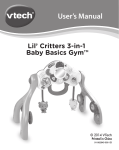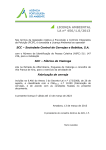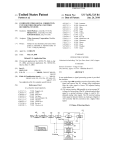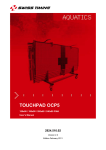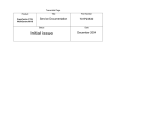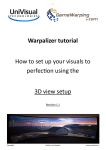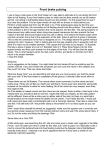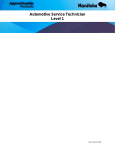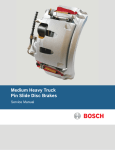Download Introduction to Foundation Brake Design
Transcript
Introduction to Foundation Brake Design Jack Limberg E and J Enterprises, L.L.C. Bosch St. Mary’s College Outline 1. 2. 3. 4. 5. 6. 7. 8. 9. 10. 11. A Brief Review of Physics Some Brake History Basic Brake Operation Disc Brakes – Why? Disc Brakes – Types/Caliper Body Disc Brakes – Pistons Disc Brakes – Seal Disc Brakes – Protective Parts Disc Brake Pads Disc Brake Rotors Some Information and Trends 2 Disclaimer This tutorial is NOT a “Cook Book” to design foundation brakes. Rather, it is intended to present some fundamental guidance and terminology to the newly designated “Brake Engineer” for application in their role to provide brake hardware for their employer and customer vehicles. As the saying goes, “Experience is the best teacher, but the tuition is rather high”. Welcome to the Automotive Brake Engineering Community. Always remember what the brake hardware is expected to do for the customer. 3 A Brief Review of Physics Newton’s First Law: Every object remains at rest or in motion in a straight line at constant speed unless acted on by an unbalanced force. When we want to stop the vehicle from any velocity we need the Foundation Brakes to provide that “unbalanced force”. They do this by generating torque which is used to apply the force at the tire to road interface (the tire patch). So we have the first primary job of the foundation brake: Generate Torque 4 Introduction to Foundation Brake Design A Brief Review of Physics How much torque do we need? Newton’s Second Law: The net force on an object is equal to its mass times its acceleration and points in the direction of the acceleration. In our case the acceleration is opposite the direction of travel and called deceleration by automotive brake engineers. The proper front to rear distribution of the torque is a fundamental brake system design challenge. The system engineer specifies to the foundation brake engineer how much torque to generate by brake sizing and friction material selection. 5 A Brief Review of Physics While we’re at it, let’s review Newton’s Third Law 6 A Brief Review of Physics The reaction in progress: 7 A Brief Review of Physics More reaction in progress: 8 A Brief Review of Physics And here is the final reaction (equal and opposite): 9 A Brief Review of Physics The Laws of Thermodynamics dictate that energy cannot be created or destroyed, it can only be converted or transferred. To get the vehicle moving we convert some of the energy in the fuel with the engine and drive train into kinetic energy (KE = ½ m v²) To stop the vehicle we usually convert its kinetic energy into heat energy (not considering regenerative braking). Sizing and materials of foundation brakes is important because of this mandatory compliance to natural law for the conservation of energy. The components have to convert the kinetic energy into heat energy and transfer this into the atmosphere. Things can get hot! Therefore, the two fundamental functions of foundation brakes: 1) Generate Torque 2) Convert and transfer energy. 10 Some Brake History The first known vehicular brake, the Locked Wheel 11 Some Brake History It is believed that the Romans used a chariot brake. One end of a chain was attached to a chariot chassis, while the other end was held by the driver. The major advance of this brake was that it allowed the amount of braking force to be varied. 12 Some Brake History Another advance was in the 1800’s. The typical wagon used a wooden brake shoe that was pressed against the wheel rim by lever-operated linkages. 13 Some Brake History The first automobiles were little more than wagons or carriages fitted with engines and drive trains. With the invention of rubber tires, the rim-contact wagon brake became impractical. To solve the problem, a metal brake drum was attached to the inside of the wheel to provide a rubbing surface for the brake shoe. 14 Some Brake History As time went by, the speeds attained by the newer models exceeded the ability of the brakes to stop them safely and reliably (too much energy into heat raising temperatures causing brake power loss and quick wear out). Initial solution was to increase the surface area of the lining material led to the band brake. 15 Some Brake History The solution for the problems of the band brake was the hydraulic actuated internal expanding shoe brake. 16 Some Brake History As highway speeds and the size and weight of vehicles continued to increase, it became apparent that even the largest practical drum brakes were unable to adequately transfer the heat generated during repeated braking. Hence disc brakes became more in use. 17 Typical Modern Automotive Brake System Typical Passenger Vehicle Brake System Drum -In -Hat Brake Assembly Tone Wheel Parking Brake Cable Parking Brake Hand Control Hydraulic Control Unit Brake Hose Brake Tube Rotor Proportioning Valve Wheel Speed Sensor Brake Pedal Electronic Control Unit Caliper Assembly Vacuum Booster Friction Material 18 Master Cylinder Master Vac ™ Basic Brake Operation An automobile’s brake system must be able to slow or stop the vehicle when in motion and it must be able to hold the car in position when stopped on an incline. Automotive brakes have two interrelated systems: 1) Service Brakes 2) Parking Brakes 19 Basic Brake Operation All brake systems work in accordance with the physical “laws” or principles that describe the relationships between elements of our physical world such as: Energy Inertia Hydraulics Mechanics Friction 20 Basic Brake Operation Energy: can be defined as the ability to do work Work: transfer of energy from one physical system to another – especially the transfer of energy to an object through the application of force. Formula: Work = Force x Distance Automotive Brakes: the force input by the driver is multiplied by the actuation system and enables the energy of the vehicle’s motion to be transferred to the brake drums or rotors where friction converts it into heat energy and stops the vehicle. 21 Basic Brake Operation Kinetic Energy: the energy of mass in motion The amount of that energy is determined by the object’s mass and speed. Kinetic Energy is based on speed and mass, not weight. Weight is the mass of an object acted upon by the force of gravity. Since the force of gravity is relatively constant on Earth, we can use the terms weight and mass interchangeably in this tutorial 22 Basic Brake Operation Weight and speed contribute to kinetic energy – they do not affect it to the same degree – speed has a much greater effect. Baseball example: thrown at 10 mph is nearly harmless but a fastball at 90 mph can cause harm; both have the same weight Formula: KE = ½ m v² The relationship between weight, speed and kinetic energy have significant practical consequences for the brake engineer. 23 Basic Brake Operation Kinetic energy increases in direct proportion to vehicle weight but as the square of the vehicle speed 24 Basic Brake Operation Weight transfer increases the load on the front wheels while the load on the rear wheels is reduced. 25 Basic Brake Operation For the foundation brakes to convert kinetic energy into heat they must be applied with great force. The force required to stop a vehicle is so great that leverage and hydraulics are used to facilitate a person to apply it (We’ll not consider boosters in this tutorial). The primary mechanical principle used to increase the application force in every brake system is leverage. Lever: a simple machine that consists of a rigid object that pivots about a fixed point called a fulcrum. 26 Basic Brake Operation Three types of levers: first-class: increases force and changes direction (example: seesaw) second-class: increases force in the same direction (example: wheelbarrow) third-class: reduces force but increases speed (example: catapult) Levers in brake systems are used to increase force so they are either first or second class levers. 27 Basic Brake Operation In addition to mechanical advantage, hydraulic principles are used to increase the brake application force. Hydraulic systems are very efficient at transmitting motion and force. Hydraulic systems use liquids to transmit motion (by moving a volume of the liquid) 28 Basic Brake Operation For all practical purposes, a liquid cannot be compressed. A gas, such as air, will compress and a hydraulic system MUST be free from air to work properly. 29 Basic Brake Operation Brake hydraulic systems not only transmit motion they also transmit force in the form of pressure. Pressure in a brake system is primarily determined by 2 factors (Not including the booster’s power assist): 1) 2) force on the brake pedal multiplied by the mechanical advantage of the pedal ratio surface area of the master cylinder piston 30 Basic Brake Operation Recall that the area of the master cylinder affects equal hydraulic pressure in the system and weight transfer requires more front brake force and lighter rear brake force. The differences in force are obtained by using different sized pistons in the wheel cylinders and/or calipers. Remember: Piston AREA not diameter affects the force 31 Basic Brake Operation The application FORCE, 400 lbs. in the brake caliper is solely the result of 100 psi acting on a 4 square inch piston (4 x 100 = 400) Just as larger pistons increase the force, smaller pistons decrease it. The ¾ (0.75) inch wheel cylinder results in a 75 lbs. force, (.75 x 100 = 75) 400 lbs. 75 lbs. 75 lbs. 32 Basic Brake Operation The ability of a hydraulic system to increase and decrease forces appears to be a convenient thing. However, there is another side to the process that must be considered. There is the First Law of Thermodynamics which can be simply stated as whenever one kind of energy is increased, another kind must be decreased. Or in simpler words, you don’t get something for nothing. Or as Dr. Tarara at St. Mary’s College paraphrases the Laws of Thermodynamics: 1) You Can’t Win 2) You Can’t Break Even 3) You Can’t Get Out of the Game 33 Basic Brake Operation In our example, the force at the caliper was 4 times greater because of the size difference between the master cylinder and caliper pistons. Some of the hydraulic energy is converted into increased mechanical force. The tradeoff is the larger piston will NOT move as far as the smaller piston. The amount of hydraulic motion is decreased. Another way to remember: Force x distance must equal each other 34 Basic Brake Operation Think of how a floor jack works: You have a long lever in the handle and you pump it many times (each stroke length is added to the next) with a relatively low force to move a heavy object off the ground that requires a larger force. However,with a brake master cylinder, you only get one stroke. 35 Basic Brake Operation The brakes at the wheels use friction to convert vehicle kinetic energy into heat energy. Friction is the resistance to movement between two surfaces in contact with one another. Amount of friction between to objects or surfaces is commonly called the coefficient of friction (Symbol µ; pronounced mu). Three factors affect the friction coefficient of vehicle brakes: 1) Surface finish 2) Friction material 3) Heat effects 36 Basic Brake Operation 1)Surface finish: for example; rough and smooth wood on concrete versus on smooth marble. The surface finish of automotive drums, rotors and linings is greatly influenced by the fact that they must be smooth enough for good wear. 37 Basic Brake Operation 2)Friction material: For example; replace ice for the wood. The type of materials being rubbed together has very significant effect on the coefficient of friction. 38 Basic Brake Operation 3) Heat effects: Heat (temperature) affects the coefficient of friction but its effect is the most difficult to verbalize because it has varied influence at different times and on different types of friction material. Graph shows one possibility. 39 Basic Brake Operation Usually for sliding surfaces in brake assemblies, the amount of contact width has little effect on the amount of friction generated. To have a coefficient of friction of 1.0 or more, material must be transferred between the two friction surfaces. Tires are an example. The tire and road usually do NOT have a sliding relationship. A tire conforms to the road surface and during a hard stop a portion of the braking force comes from tearing away of the tire tread rubber. The rubber’s strength (its resistance to being pulled apart) adds to the braking friction and can be seen as skid marks. Wider tires provide more material resisting being pulled apart and different rubber compounds have different strengths. Because of this, different tires have different coefficient of friction and some can be measured as having a coefficient of friction of 1.0 or slightly greater. 40 Basic Brake Operation Brake linings having a coefficient of friction of less than 1.0 is not a deficiency. They have to be easily controlled as not being “grabby” and not wear out too quickly while managing the heat generated. The amount of contact width may not greatly affect the coefficient of friction, but it does offer considerable effects on lining life and the dissipation of heat converted from the vehicle’s kinetic energy. 41 Basic Brake Operation A full stop from 30 mph creates far less temperature rise than slowing a vehicle from 60 to 30 mph or 90 to 60 mph. The vehicle is slowed by 30 mph but the brake system must convert more energy from the higher speed. 42 Basic Brake Operation Sometimes brake drums and rotors are forced to absorb the heat of braking faster than they can dissipate it into the atmosphere. If repeated high energy stops are demanded of a brake system, it can overheat and lose effectiveness, or even possibly fail altogether. This loss of braking effectiveness is called Brake Fade. 43 Basic Brake Operation Usually brake fade is temporary. The vehicle’s brakes will return to a more normal performance after they have cooled. However, the high temperature changes the lining and drums/rotors which can cause customer satisfaction issues such as squeal noise, grabs, pulls or vibration. In some extreme situations the high temperature could have damaged the friction material, the rubber boots or seals or even caliper pistons and sliding parts in the foundation brake assemblies. 44 Disc Brakes – Why? FMVSS 105a in 1966 started the trend to front disc brakes even though disc brakes were already on several high performance vehicles (e.g. Corvette; there is an interesting story about what Corvette owners allegedly used to do to the CHP.) The higher levels of braking performance specified in the 1976 revision of FMVSS 105 virtually guaranteed that manufactures would use only disc brakes on front axles of new vehicles. The main performance advantages are: ! Fade resistance (Both for high temperature and water soaking) ! Reduced tendency for pull (stay within 12 ft. lane requirement) 45 Disc Brakes – Why? Lining Fade: The lining material overheats, its friction coefficient drops and lining fade occurs. Primary symptom is a hard pedal and requires the driver to apply greater force to maintain stopping power. Point at which it occurs in disc brakes is much later than in drum brakes and recovery is faster. 46 Disc Brakes – Why? Fade Resistance: A disc brake compared to a drum brake of similar diameter has a greater ability to resist fade. One reason for this is the cooling ability since all the major parts are usually exposed to air flowing over them. Also, many rotors have cooling passages cast into them to help reduce operating temperatures. However, with the demands for high number of multiple stops temperature requirements on today’s vehicles, this is an area where the OEM’s need more R&D for improved heat transfer (air flow) to transfer the heat into the atmosphere. 47 Disc Brakes – Why? Swept Area: The amount of brake drum or rotor friction surface that moves past the brake linings every time the drum or rotor completes a rotation. Larger swept area allows heat generated to be transferred more rapidly for better cooling. Disc brake has swept area on BOTH sides of the rotor; a drum brake has it ONLY on the inside of the drum. 48 Disc Brakes – Why? Water Fade: Two factors help keep water from between the lining and rotor: 1) Centrifugal force created by the spinning rotor throws off most water 2) Pad continuously wipe the rotor clean 49 Disc Brakes – Why? Reduced tendency for pull: A vehicle with disc brakes will stop straighter under a wider range of conditions than with drum brakes (all other things being correct: e.g. suspensionespecially caster variation, wheels & tires, bearings to properly handle the loading and forces during braking action). Two features make this possible: 1) Self cleaning ability 2) No self energizing or servo action Drum brakes rely on item 2) above and a small loss of friction causes a larger loss of brake torque (e.g. same reason for quicker fade) and a significant side to side variation of braking force can result. With disc brakes the effects of a small loss of friction on one side of the vehicle are far less pronounced than with drum brakes. 50 Disc Brakes – Not Utopia Probably the biggest complaint about disc brakes is that they sometimes make irritating noise: usually rattling or vibration moan, squeaks or squeals. Various anti rattle clips or springs are used to reduce or eliminate rattle noises. Some lining materials have better damping of vibrations before exciting the system into audible moans, squeaks or squeals. Some have special shims (also known as noise insulators) between the pad and the caliper to damp vibrations. A flexible bond (constrained layer damping) is created that affects the natural frequency of the pad and damps the tendency for vibration. 51 ALWAYS Remember the Basics and do the FMEA with the Operator in Mind: 52 Disc Brakes – Types/Caliper Body There are many different designs but all contain the following basic parts: • • • • • • Caliper body Bleed Screw Pistons Piston seals Dust boots Pads 53 Disc Brakes – Types/Caliper Body Bleed Screw Caliper Housing Piston Piston Seal Pads Piston Boot a.k.a. Dust Boot 54 Disc Brakes – Types/Caliper Body Foundation of any disc brake is the caliper body: the U-shaped casting that wraps around the rotor (like a hydraulic C-clamp) is usually made of Nodular cast iron but some are aluminum for lighter weight. 55 Disc Brakes – Types/Caliper Body Single piston calipers are usually one piece, and multi piston calipers that have pistons on both sides of the rotor are made in two pieces that are bolted together with high strength bridge bolts. 56 Disc Brakes – Types/Caliper Body Most calipers have an inspection hole in the bridge where the pad thickness can be quickly checked. 57 Disc Brakes – Types/Caliper Body Calipers that bolt solidly to the knuckle are called fixed calipers and they do not move at any time. 58 Disc Brakes – Types/Caliper Body Fixed Caliper: Body usually manufactured in two halves; has two, three or four pistons Gets its name from the fact that it is rigidly mounted to the knuckle; no part of the caliper body moves when the brakes are applied. Advantages: Size and rigid mounting does not flex much Strong and provides a firm and linear brake pedal feel Strength and heat dissipating ability ideal for heavy duty use Disadvantages: Weight, cost and complexity usually cannot be justified for the lower speeds and more moderate braking in U.S. More difficult to service with more opportunity for leaks 59 Disc Brakes – Types/Caliper Body Fixed Caliper Alignment: Must be centered over the rotor and aligned for pistons to contact the pads parallel to the rotor If not properly aligned, pistons will be at an angle and cause taper wear of the linings and if too much misalignment, pistons could cock in their bores causing wear and possibly cracking 60 Disc Brakes – Types/Caliper Body Floating / Sliding Calipers: Not rigidly mounted, are free to move within a limited range on an anchor that is solidly mounted to the vehicle Anchor may be cast into the knuckle or it can be a separate piece that bolts on 61 Disc Brakes – Types/Caliper Body When floating / sliding disc brakes are applied the caliper piston moves out of its bore and forces the inner pad against the rotor while the pressure on the closed end of the bore moves the caliper body in the opposite direction forcing the outer pad against the rotor at the same time. The caliper body moves every time the brakes are applied. 62 Disc Brakes – Types/Caliper Body Floating / Sliding Calipers Advantages: Biggest advantages are lower cost, simple construction and compact size. Fewer pieces: cost effective to build and service with fewer potential leak points. Smaller size usually allows better packaging on the vehicle (less room required on the outboard side at the wheel). Better suited for parking brake role. Can be mechanically actuated by applying a single inboard piston with a cable and lever mechanism. 63 Disc Brakes – Types/Caliper Body Floating / Sliding Calipers Disadvantages: Allows a degree of flex in the caliper suspension which may contribute to a slight spongy pedal feel. Caliper suspension flex also allows the body to twist slightly when brakes are applied which can cause taper lining wear. Do not have the mass of fixed calipers and the flexible mounting systems slow the transfer of heat from the caliper body to the anchor plate and other vehicle components that aid the cooling process. 64 Disc Brakes – Types/Caliper Body A caliper body usually contains 1 to 4 bores that contain the pistons. If one piston/bore is used, it is on the inboard side of the caliper and is a floating / sliding caliper. 65 Disc Brakes – Types/Caliper Body Two piston/bore calipers can have them located on both sides of the rotor and is usually a fixed caliper or only on the inboard side when it is a sliding caliper 66 Disc Brakes – Types/Caliper Body Three piston/bore calipers are rare. They have 1 large bore on the inboard side of the rotor and 2 smaller bores on the outboard side 67 Disc Brakes – Types/Caliper Body Four piston/bore calipers have 2 bores on both sides of the rotor and are usually fixed calipers 68 Disc Brakes – Types/Caliper Body Pressure is supplied to the piston bores through a brake line inlet machined into the caliper body; always on the inboard side to facilitate hose clearance to other vehicle components. Fixed calipers, usually made in two pieces, use one of two methods to provide fluid/pressure to the outboard piston/bores: 1) Machined passages in the castings that are sealed at the caliper joining surfaces with rubber O rings 2) External cross over tube 69 Disc Brakes – Types/Caliper Body Bleeder screws are located at the highest point of the bore(s) when the caliper is installed on the vehicle (don’t forget the caster angle). BLEED SCREW ALWAYS ON TOP where the air will be and try to think about the technicians who will be working on your design in this regard and with other features incorporated. 70 Disc Brakes - Pistons Brake caliper pistons form the interface between the hydraulic system and the mechanical action of the disc brake by moving outward in the bore converting pressure to mechanical force pushing the pads against the rotor to stop the vehicle. They must be: strong durable resist corrosion maintain size & shape under extremes of temperature and pressure ! light as possible to reduce unsprung weight ! prevent or slow the transfer of heat to the brake fluid. ! ! ! ! 71 Disc Brakes - Pistons • Inner surface of caliper pistons is surrounded by brake fluid in the bore • Outer side presses against the metal backing plate of the brake pad • Brake pads routinely operate above brake fluid boiling temperature • Brake pads can be several hundred degrees above brake fluid boiling temperature during heavy use • Some of this heat is transferred into the caliper piston and from there to the brake fluid • If too much heat is transferred through the piston, the brake fluid can boil and vapor lock will occur (too much compressible gas to operate normally) 72 Disc Brakes - Pistons " Centers of most caliper pistons are hollow reducing the surface area in contact with the brake pad " The airspace in the hollow area also serves as an insulator " Most important factor affecting heat transfer is the caliper piston material 73 Disc Brakes - Pistons Aluminum pistons: very light weight with some disadvantages: • Expands much faster than cast iron when heated; requires fairly large clearance in the bore and can lead to leaks (also shrinks much faster in cold) and other problems. • Although anodized, more susceptible to corrosion and scuffing • Excellent conductor of heat and poor at keeping heat away from brake fluid (also loses strength at high temperatures) Steel pistons: very strong and maintain size and shape over a wide range of temperature and pressure • Chrome plated to resist corrosion • Relatively heavy and conduct more heat than desirable in hotter running brake systems. 74 Disc Brakes - Pistons Phenolic pistons: Advantages: " Inexpensive (no need to chrome plate) " Light weight " Strong " Highly corrosion resistant " Provide greater piston retraction " Poor conductor of heat or excellent insulator to keep brake fluid temperature lower than with metal pistons Technicians in the field have resisted phenolic pistons. Some concerns were justified while others were not. 75 Disc Brakes - Pistons Early calipers with phenolic pistons suffered from pistons sticking in the bore. Studies have shown such problems resulted primarily because of caliper bore corrosion caused by poor dust boot sealing from improper installation. Press-in boot design has resolved the issue and today’s technicians are better educated in working with phenolic pistons. No prying with screw drivers or pushing the piston back into the bore with the c-clamp pressing on the bottom surface of the piston which will cause piston damage. Phenolic pistons will provide a normal service life if the caliper dust boot is installed properly, remains intact and not damaged from excessive high temperature exposure. 76 Disc Brakes - Pistons Phenolic pistons have a higher thermal coefficient of expansion than steel. To compensate for this, phenolic pistons are designed slightly smaller in diameter to provide for slightly more piston to bore clearance (around .007” - .010” diametric clearance). This also requires the caliper bore be very round and not oval shaped. A very flexible caliper body may cause unusual side loading on the piston and keep in mind that phenolic does not have very high flexural strength. Piston length is a very key parameter. Remember when the lining wears out and the rotor is made thinner by wear and machining, the piston could come out of its seal and cause a rapid loss in braking power. Providing for adequate seal coverage is a basic fundamental in disc brake design no matter what the piston material. 77 Disc Brakes - Seal Calipers require seals to prevent fluid from escaping through the clearance between the piston and its bore. Early disc brake designs sometimes experienced unacceptable piston “knockback”. This knockback causes inconsistent and excessive pedal travel at brake apply. Can be quite a surprise. . 78 Disc Brakes - Seal Most seals are lathe-cut “O” rings with a square cross section that fit into a groove machined into the caliper body bore. The piston slides through the inside of the seal; outside diameter of the piston provides one sealing surface and the seal groove is the other sealing surface. This is usually a compression fit. With seal located at open end of the bore, the piston sealing surface for lining wear is in brake fluid and protected from harm. However, the seal land in the body and the piston outside the seal will be exposed to contamination if the dust boot is damaged or not properly installed. 79 Disc Brakes - Seal The seal fits tightly against the piston and holds it in position. When the brakes are applied the seal flexes outward until the pads contact the rotor. When the brakes are released the seal returns to its original shape and retracts the piston away from the rotor. 80 Disc Brakes - Seal Because the seal can only flex so far; automatic adjustment occurs to compensate for lining wear. When the amount of piston movement becomes greater than the seal can flex, the piston slides through the seal until the pads contact the rotor When the brakes are released the seal again retracts the piston but only within its limit of flex; piston travel through the seal remains. 81 Disc Brakes - Seal Piston retraction can be changed by modifying the shape of the seal groove; a larger chamfer allows the seal to flex farther and this in turn allows the seal to retract the piston farther back when the brakes are released. 82 Disc Brakes - Seal Over flexing and excessive piston to bore clearance can cause wear to the seal, called “nibble”, on the face and edges of the seal. This can eventually lead to brake fluid leakage. 83 Disc Brakes – Protective Parts Brake calipers are exposed to the hostile elements of our roadways. Rubber boots are used to prevent moisture, dirt and other contaminants from entering the bore. Generally there is one boot for each piston. In all cases the opening in the center of the boot fits tightly around the end of the caliper piston, usually in a machined groove. 84 Disc Brakes – Protective Parts There are several designs to seal the boot in the caliper body: A)Some have a metal ring around the outer edge (or molded within). The boot is pressed in a groove machined in the caliper body after the piston is installed in the bore. B)Others have an edge that fits into a groove machined in the caliper body, when the piston is installed in the bore, it captures the boot in place. C)Still others fit into a groove in the face of the caliper body and are held in place by a separate metal ring installed around it. 85 Disc Brakes – Protective Parts Splash Shield (a.k.a. Dust Shield): Used to protect the inner side of the rotor from water and other contaminants. Most are stamped steel but some are plastic to save weight. 86 Disc Brake Pads Brake Pads: Contact the rotor to create the friction that converts kinetic energy into heat when stopping the vehicle Two pads are used in a disc brake: one on each side of the rotor Designed and manufactured in all sorts of various shapes and sizes usually to fit the package space available while maximizing lining area and volume for optimum lining life All have a metal backing plate (usually steel) to which lining is molded or riveted 87 Disc Brake Pads “Lining” of a disc brake is part of an assembly called the brake pad which consists of a block of “friction material” attached to a stamped steel backing plate. Disc brake pads operate under the most extreme conditions in the entire brake system and are subject to a great deal of temperature variations and contaminants. Although they appear to be simple parts, modern disc brake pads are the result of years of engineering and development. 88 Disc Brake Pads Some pads have wear indicators. Either mechanical or electrical that signal the driver when friction material has worn and replacement is necessary Mechanical: small spring-steel tab attached to the backing plate that contacts the rotor making a squealing/chirping noise when brakes are not applied to alert the driver Electrical: coated electrode placed in the lining that is wired to a warning light in the instrument panel and that grounds against the rotor to complete the circuit and turn on the warning light. 89 Disc Brake Pads Friction Material: The most important part of disc brake pads from an overall brake performance perspective. Different brake designs require different kinds of friction material. Disc brakes routinely operate at much higher temperature than drum brakes and require pad friction material to have a greater resistance to this high temperature. No one type can do everything well under every condition (friction, wear, temperature, noise, etc.) 90 Disc Brake Pads Friction materials are made from mixtures of several elements that are blended together in precise ratios and molded under controlled heat and pressure. Exact formulations are rarely disclosed because they are considered as proprietary secrets. Four basic categories: 1) Organic 2) Metallic 3) Semi-Metallic 4) Synthetic 91 Disc Brake Pads Despite the many differences, some generalizations can be made about the friction coefficient of each type of friction material: Nonasbestos Organic: • European type: around 0.45 to 0.55 • U.S. & Japanese type: around 0.35 to 0.40 Semi-Metallic: around 0.35 to 0.40 Sintered Metallic: around 0.25 to 0.35 Disclaimer: These are only ballpark numbers for conversation and basic comparison as related to brake effectiveness. The coefficient of friction is dependent upon many variables, especially temperature, and can only be determined when measured with all the variations possible. 92 Disc Brake Pads Various U.S. state’s edge code requirement contains several pieces of information about the particular friction material: For example: R/M 6793-2 EF The first letters (R/M) identify the manufacturer The numbers in the center (6793-2) identify the material compound designation The final two letters (EF) describe the cold and hot friction coefficients based on SAE J661a testing. The first letter is for the cold and the second is for the hot friction class code. This is simply a means of identification and does not represent friction requirements for linings or quality characteristics and should not influence the selection of a lining for a particular vehicle. 93 Disc Brake Pads Note: Further in the alphabet indicates a higher friction code. Most linings for passenger cars and light trucks are in the E, F and G classes Friction Class Code Coefficient of Friction C D E F G H Not over 0.15 0.15 – not over 0.25 – not over 0.35 – not over 0.45 – not over Over 0.55 Over Over Over Over 94 0.25 0.35 0.45 0.55 Disc Brake Pads The friction material must be firmly attached to the disc brake backing plate. Following are the methods used: Riveting: Oldest method. Lining attached with metal rivets, usually steel. Drawbacks: • Lining thickness below the rivets is about 1/4 to 1/3 of total thickness reducing service life because pads must be replaced before rivets score the rotor. • Rivet holes create stress points where cracks can develop. 95 Disc Brake Pads Mold Bonding (a.k.a. Integrally Molded): Manufacturing process that combines bonding with some mechanical attributes of attachment. One or more holes are made in the pad backing plate. " High temperature adhesive is applied to pad backing plate. " Uncured friction material is formed onto the plate and forced into the holes. " Pad is cured under heat and pressure and the bonding adhesive combines with the portions of lining extending into the holes in the backing plate to attach the lining in place. 96 Disc Brake Rotors Rotors are the largest and heaviest parts of the disc brake assembly. They provide friction surfaces for the linings to rub against and together these parts create the “friction couple” that converts kinetic energy into heat and stops the vehicle. They absorb and dissipate most of the heat generated in braking. Made of cast iron because of its relative: low cost, good wear and friction properties and ease of machining. 97 Disc Brake Rotors Typical rotor is a circular metal plate with two machined friction surfaces, one on either side The raised portion of the rotor is called the “hat” or “hat section”; its looks like a “top hat”. 98 Disc Brake Rotors Solid Rotor: One whose friction surfaces are on the opposite sides of a solid piece of metal (usually used on lighter, less powerful vehicles) Vented Rotor: Has cooling passages cast between its friction surfaces allowing cooling air to enter the center portion and exit at the outer edges intended to provide lower operating temperature for better rotor and lining life and improved fade resistance. 99 Disc Brake Rotors To paraphrase a bumper sticker: “Stuff Happens” Damage to the friction surface usually is the result of extremes in brake operation, extremes of wear, stress, temperature or temperature variation. Various things can and will happen to the rotor in the real world: Scoring: Extreme form of wear consisting of scratches, deep grooves and a rough finish on the friction surface. Most common cause is when linings have worn to the point where rivets, table or pad backing plate contacts the drum or rotor. 100 Disc Brake Rotors Cracking: o Caused by stress of severe braking or an impact during a crash. o Can appear anywhere on a rotor, usually at the edges of the friction surface. 101 Disc Brake Rotors Heat Checking: ! Many small interlaced cracks on the friction surface. ! Typically penetrate only a few thousandths of an inch and do not go into the structure of the drum or rotor. ! Can cause rapid lining wear and slight pedal pulsation or noise. 102 Disc Brake Rotors Hard Spots: • Caused by brake temperatures becoming too high. • Localized impurities in the metal can be burned away altering the structure of the metal. • Roughly circular bluish/gold, glassy appearing areas on the friction surface Issues created by: # Harder than the surrounding areas; when start to stand out from the rest, can cause rapid lining wear. # Coefficient of friction less than other areas so braking is uneven causing chatter or pulsating. # More likely to crack in such an area. 103 Disc Brake Rotors For smooth braking without pedal pulsation or other issues, the rotor friction surfaces must maintain a fixed position in relation to the pads. Sometimes a position variance less than one thousandth of an inch (0.001”) will create a braking problem. Friction surfaces of a rotor in perfect condition are perpendicular to the axle centerline and have no side-to-side movement. Friction surface distortion is very significant in a disc brake because of the hydraulics principles making the different piston movements between caliper and master cylinder pistons. A very small rotor distortion can cause large amounts of pedal pulsation. 104 Disc Brake Rotors Lateral Runout: Side-to-side wobble of the rotor as it rotates on the spindle. If too great, excessive pedal travel and front end vibration can result and lead to pedal pulsation. Causes: Over-tightening or unevenly tightening wheel lug nuts or bolts Extreme heat or rapid temperature variations Inaccurate machining 105 Disc Brake Rotors Thickness variation: Thickness variation (usually at one place but sometimes at several places) around the rotor friction surfaces circumference. The most common cause of pedal pulsation and front end vibration during braking. Causes: " Excess runout causing uneven wear " Friction material resin uneven build up " Deformation after experiencing high temperature " Rust build up when vehicle is not driven for extended period Because thickness variation much more likely to cause a complaint, specification is much smaller, usually within a half a thousandth of an inch (0.0005”) or less. 106 Disc Brake Rotors Limits are put on rotors usually called the ‘Rotor discard dimension’ to provide technicians in the field with direction when to replace them. A too thin rotor can cause the piston to disengage the seal and a loss of braking. 107 Disc Brake Rotors Some things to include in the service manual about rotors: Should remove at least a small amount of metal on both sides to minimize runout, maintain parallelism and provide a consistent friction surface between the two sides. Must remove the same amount from both sides with fixed calipers to maintain proper caliper alignment. Also, if maximum allowable were removed from one side, the caliper piston(s) might extend too far out of the bore(s) and cock, jam or create a leak and hydraulic system failure. Sliding or floating calipers, since they center themselves over the rotor, can accommodate a moderate difference in amount of metal removed from the friction surfaces. 108 Some information and trends Vehicle Type Model Year Front Rotor Effective Weight Front Rotor Plate Area Vehicle GVW Model Year Front Rotor Effective Weight Front Rotor Plate Area Vehicle GVW SUV A 1996 15.4 lb./7.0 kg 123 sq. in./793 sq. cm 5580 lb./2531 kg 2002 19.2 lb./8.7 kg 124 sq. in./799 sq. cm 6040 lb./2740 kg Light Truck A 1997 14.6 lb./6.6 kg 117 sq. in./756 sq. cm 5950 lb./2700 kg 2003 19.2 lb./8.7 kg 130 sq. in./822 sq. cm 6000 lb./2721 kg Light Truck B 1997 18.7 lb./8.5 kg 129 sq. in./830 sq. cm 6500 lb./2948 kg 2004 25.8 lb./11.7 kg 151 sq. in./971 sq. cm 8200 lb./3719 Light Truck C 1994 19.8 lb./9.0 kg 125 sq. in./806 sq. cm 6400 lb./2903 kg 2002 25.1 lb./11.4 kg 150 sq. in./964 sq. cm 6815 lb./3091 kg 109 Some information and trends Vehicle Type Model Year Initial (new) Front Lining Area Front Lining Volume Vehicle GVW Model Year Initial (new) Front Lining Area Front Lining Volume Vehicle GVW SUV A 1996 21.9 in.²/141 cm² 13.5 in.³/221 cm³ 5580 lb./2531 kg 2002 31.3in.²/202 cm² 13.8 in.³/226 cm³ 6040 lb./2740 kg Light Truck A 1997 12.2 in.²/78.8 cm² 6.77 in.³/111 cm³ 5950 lb./2700 kg 2003 14.2 in.²/91.9 cm² 8.12 in.³/133 cm³ 6000 lb./2721 kg Light Truck B 1997 33.6 in.²/217 cm² 14.3 in.³/ 235cm³ 6500 lb./2948 kg 2004 27.6 in.²/178 cm² 20.3 in.³/332 cm³ 8200 lb./3719 Light Truck C 1994 Unknown in.²/ cm² Unknown in.³/ cm³ 6400 lb./2903 kg 2002 15.8 in.²/102 cm² 8.91 in.³/146 cm³ 6815 lb./3091 kg 110














































































































